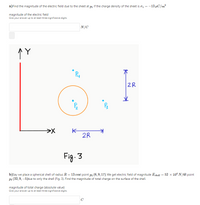Question

Transcribed Image Text:a) Find the magnitude of the electric field due to the sheet at pi if the charge density of the sheet is o = -13 µC/m?
%3D
magnitude of the electric field
Give your answer up to at least three significance digits.
N/C
Pu
2R
K
2R
Fig. 3
b)Say we place a spherical shell of radius R = 13 cmat point p2 (6, 9,17) We get electric field of magnitude Eshelu = 52 × 104 N/6t point
P3 (32, 9, –5)due to only the shell (Fig. 3). Find the magnitude of total charge on the surface of the shell.
%3D
magnitude of total charge (absolute value)
Give your answer up to at least three significance digits.
C
Expert Solution
This question has been solved!
Explore an expertly crafted, step-by-step solution for a thorough understanding of key concepts.
Step by stepSolved in 2 steps with 1 images

Knowledge Booster
Similar questions
- Problem 10 A sphere has a constant interior charge density p. What is the electric field for all values of r? Inside and outside? Plot the strength of the electric field as a function of r.arrow_forwardA uniformly charged disk of radius R=25 cm carries a total charge of Q=2 μC. R P 1 Find the magnitude of the electric field E created by the disk at the point P located at distance 40 cm from the center of the disk. E = [N/C] 2. What is the direction of the electric field E created by the disk at point P. Direction: 3. Write the expression of the electric filed E created by the disk at point P. Ē =< [N/C] 4. Find the magnitude of the electric field E created by the disk at the point P located at distance 8 m from thearrow_forwardFigure 3 shows six planes which are put together to form a cuboid. Determine the total charge enclosed by the cuboid using Gauss's Law if electric flux density is given as D = 3x²a, + y²â, + 2z²a, C/m². (1, 3, 2) (3, -2, 0) (3, 3, 0) Unit: m Figure 3arrow_forward
- Inner sphere radius: R1 Shell radii: R2 and R3arrow_forwardProblem 1 The figure below shows three concentric conducting thin spherical shells: • Sphere A of radius R₁ = 6 cm and a total charge QA = 2 nc. • Sphere-B of radius Rg = 21 cm and a total charge QB = -4 nC ⚫ Sphere-C of radius Rc 78 cm and a total charge Qc Qc is an unknown charge. Re RB RA B 1 What is the net electric flux o through the spherical surface of radius r = 13 cm from the center of the spheres? 2 spheres? E= 3. spheres? E= What is the magnitude of the electric field E at r = 59 cm from the center of the What is the magnitude of the electric field E at r=2 cm from the center of the 4. If the magnitude of the electric field is E 192 N/C at r = 93 cm from the center of the spheres, calculate Qc. Qe=arrow_forwardParts A through Darrow_forward
- A spherical charge distribution of radius R is given by ρ = ρ0(1 – r/R), where r is the radial distance and ρ is the volume charge density. The electric field E is maximum at r equals: Zero 2.0R R/3 2R/3 0.745R Clear my choicearrow_forwardThere are three static charges (Q1 = 4 nC, Q2 = - 4 nCn and Q3 = - 4nC) located in different locations of Fig. 1. Calculate the net electric field at the given point P.arrow_forwardric Fields due to Point Charges An uneven dipole is located along the x-axis and centered on the origin as drawn. Its positive end has twice as much 2a 1 charge as its negative end. Each charge is located a distance a away from the origin along the x-axis. In terms of k, q, and a, find the electric field vector only at а POINT 1 and POINT 2. Your answers should be simplified 2 numerically until they are in the form: E = (0.123, -2.345), for example. -2a +29 2aarrow_forward
- The cube in the figure (Figure 1)has sides of length L=10.0 cm. The electric field is uniform, has a = magnitude E 4.00 x 103 N/C, and is parallel to the xy-plane at an angle of 36.9° measured from the axis toward the +y-axis. +2 What is the electric flux through the cube face S₁? 1 ΑΣΦ Φι Figure Submit Request Answer ▾ Part B What is the electric flux through the cube face S2? ΜΕ ΑΣΦ 42 = Submit Request Answer ▾ Part C What is the electric flux through the cube face S3? ΜΕ ΑΣΦ 43 = Submit Request Answer ▾ Part D 1 of 1 S₂ (top) S6 (back) What is the electric flux through the cube face S4? ΜΕ ΑΣΦ ? N.m²/C ? N-m²/C ? N. m²/C ? N.m²/Carrow_forwardYou may want to review (Pages 673-676). Figure q (inside) (+) Q 1 of 1 Part A What is the net electric flux through the torus (i.e., doughnut shape) of the figure (Figure 1)? Assume that Q = 250nC and q = -3.0nC. Þ= IV- ΑΣΦ Submit Provide Feedback Request Answer F ? N m²/Carrow_forwardA long cylindrical conductor of radius r:= 5.0cm has a uniform charge density of 0:= 4.0 on it surface. This cylinder is surrounded by a concentric conducting μα µC cylinder of radius rɔ:= 8.0cm and uniform charge density of 2:=-2.5. 2 m on its surface 5) Find the Efield at a distance 'r" in between the two conductors rįarrow_forwardarrow_back_iosarrow_forward_ios